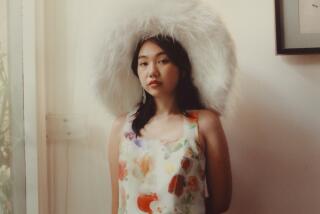Shopping: Quilts : Stiches in Time : Hawaiian quilts get a fresh airing as a new generation discovers their special beauty
- Share via
AHAINA, Maui — Wailani Johansen sits by her quilting frame in the living room of her small Lahaina house, ocean breezes drifting in past the hibiscus bushes as she stitches her way into the past.
“Both my grandmothers were Hawaiian. I watched them quilt with my aunts,” says Johansen, now white-haired herself. “We used to raise our own sheep and card our own wool for batting. We wove our own fishnets, and we’d cook the fish with green seaweed and shrimp and sweet potatoes. Life was so rich. . . . When I sit here sewing, I recall all of it.”
Hawaiian quilts like Johansen’s, called kapa lau, are prized as much for their spiritual qualities as for their material value. Each one is named, and their makers claim the kapa lau are stitched with such love and prayer that they are endowed with mana, or spiritual presence. Generations of islanders have passed along family quilts as heirlooms, and when one finally deteriorates, it is burned rather than allowed to fall into disuse.
Now this art form that had been kept alive only through the patience of old Hawaiian women is enjoying a fresh airing. The abstract designs can be found blanketing beds, walls, clothes, pillows, even purses and pot holders. Quilting classes are packed with young mothers, middle-aged and recently retired women, and tourists. Prices for authentic quilts have gone through the roof, and Third World copycats have hit the market.
Custom, hand-sewn Hawaiian quilts cost anywhere from $2,000 to $8,000 and take from three months to a year to complete, depending on the quilter, the complexity of the design and the size. But Hawaiian-style designs made by hand in the Philippines and sold in Hawaii cost around $1,000, and a few Hawaiian entrepreneurs are turning out machine-made versions for as little as $250.
Oddly enough, it is tourism--often blamed for the demise of local cultures--that has spurred renewed interest in the art.
Developer Laurance Rockefeller gave Hawaiian quilting its biggest boost in 1965 when he commissioned 30 quilts to decorate the walls of his new Mauna Kea Beach Hotel (closed for renovations until December, 1995). Soon, the quilts began appearing in hotel lobbies around the state.
The developing Hawaiian sovereignty movement, which has encouraged pride in the cultural legacy of the islands, is another factor contributing to the kapa lau’s new popularity--along with the prosaic fact that contemporary furnishings mix well with the quilts’ large, bold designs.
Mystery surrounds the origin of the Hawaiian quilt, just as it veils the beginnings of all things Hawaiian, even the people themselves.
Many people believe the first Christian missionaries from New England introduced the art of quilting to Hawaii. In 1820, a group of Hawaiians boarded the brig Thaddeus as it cruised along the Big Island’s Kona coast. Lucy Thurston, in the mission party, wrote in her journal: “Monday morning, April 3, 1820, the first sewing circle that the sun ever looked down upon in this Hawaiian realm was organized. Kalakua, Queen Dowager, was directress. She requested the seven white ladies to take seats with them on mats, on the deck of the Thaddeus. Mrs. Holman and Mrs. Ruggles (were) to ply the scissors and prepare the work. . . . The four native women of distinction were furnished with calico patch work to sew--a new employment for them.”
One popular story has it that the distinctly Hawaiian style of quilt-making was born sometime later, when a woman who was drying bed linen on her lawn noticed the shadow a breadfruit tree cast upon her sheet. She was so inspired by the dramatic silhouette that she cut it out, basted it on another piece of material and stitched the first Hawaiian quilt.
But Hawaiian women were creating their own versions of decorative bedspreads by the time the missionaries arrived. Before contact with the Western world in 1778, the Hawaiians had a history of sewing with olona plant fiber and needles made from bone. They also had a taste for fine bedding and transformed tree bark into beautiful soft kapa sheets, to which they applied their own stamped designs.
“To cut new material into bits to be sewn together (as the missionaries did with their patchwork quilting) seemed a futile waste of time,” writes Stella Jones, a pioneer researcher in the study of Hawaiian quilts. “It was quite natural, therefore, that these (Hawaiian) women, accustomed each to her own designs. . . and her own individual wood-blocked patterns, should produce patterns of their own.”
Several technical characteristics distinguish the kapa lau from other American quilts. Instead of being pieced together patchwork-style from many swatches of fabric, the kapa lau is made from just two pieces of cloth: One forms the body of the quilt, while another, cut in a bold, often geometric design, is appliqued on top. The two pieces are usually, but not always, solid colors of contrasting hue.
To make a design for a Hawaiian quilt, the piece to be appliqued is folded and cut out like a snowflake from paper. Once the design is sewn onto the body of the quilt, rows of closely spaced stitching spread out from the appliqued fabric in much the same way that waves radiate from island shores. Traditional batting materials include pulu , the soft fibers of the native treefern; and human or domestic animal hair. Today it is usually wool or cotton.
Like a hula, each Hawaiian quilt tells a story, conveys a message, and has kaona , an inner, hidden meaning. Elizabeth Akana, award-winning quilter and author of the book, “Hawaiian Quilting, a Fine Art.” She recalls her children once saying of her quilts, “It’s like they talk to you.” Akana answered, “Well, they’re supposed to. You let love come from your heart through your hands and into the work. It’s love that gives it life.”
Inspiration is usually found in nature. Flowers such as ginger, plumeria, crown flower and bird of paradise are popular motifs, along with pineapples and breadfruit leaves. Waterfalls, volcanic fires and mountains appear as well. Some quilters have drawn themes from Spanish combs, ivory fans, chandeliers and even Halley’s comet. One valued quilt called “Ka Lanai O Kolomona” (Solomon’s Porch) was based on the intricate wrought-iron railings on the front porch of a man named Solomon.
History is another rich source, yielding royal crests, crowns and calabashes from the monarchy era. When the Hawaiian monarchy was overthrown by American settlers in 1893 and flying the Hawaiian flag became an act of treason, families quilted flags onto canopies of their four-poster beds so they could sleep under their beloved flag and hold it in a place of honor above their heads.
This gave rise to a whole school of Hawaiian quilt-- kapa hae , or flag quilts. Five years ago, a flag quilt sewn in 1899 fetched $44,000 (believed to be the highest price ever paid for a Hawaiian quilt) at auction at Christie’s in New York. Among Hawaiian families, they are still the most treasured--rarely displayed by their owners and surrounded by an air of secrecy.
Visitors can see Hawaiian quilts on display at several resorts and museums across the state. Two of the best hotel collections are those at the Hyatt Regency Maui and the Mauna Kea Beach Hotel (until the Mauna Kea reopens next year, part of its collection hangs at the adjacent Hapuna Beach Prince Hotel.) Museum examples include Honolulu’s Bishop and Mission Houses museums, the Lyman House Memorial Museum on the Big Island and the Kauai Museum.
Finished quilts, pillow kits, pillow shams and fashions can be purchased in many quality gift shops around the islands. If a shop claims its quilt is made in Hawaii, always ask for a certificate of authenticity. Otherwise, you may be buying an import.
Many quilt patterns are copyrighted and jealously guarded, but for those inspired to craft their own versions, traditional-style patterns in the public domain are available at the Waianae Public Library on Oahu. In gift shops, pillow kits run from $24 to $40 (compared to $35 to $70 for finished pillows). Quilting lessons are offered at several museums and stores, often for free, and can easily be squeezed into the standard Hawaiian routine.
GUIDEBOOK: Island Quilts
Here is a resource list of some of the places to buy, see and learn about Hawaiian quilts. (Area code for Hawaii is 808.)
On Oahu:
Elizabeth Akana, 46-334 Ikiiki St., Kaneohe, Hawaii 96744; local telephone 247-5358. Does commissioned work.
Bishop Museum, 1525 Bernice St., Honolulu, Hawaii 96817; tel. 847-3511. Deborah Kakalia teaches Monday and Friday, 9 a.m.-2:30 p.m., $5 per lesson.
Elizabeth’s Fancy, 767-B Kailua Road; Kailua, Hawaii 96734; tel. 262-7513. Elizabeth Root commissions Hawaiian-style quilts made by hand in the Philippines, $995 to $1,250; catalogues $3.
Hyatt Regency Waikiki, Hyatt’s Hawaii, 2424 Kalakaua Ave., Honolulu, Hawaii 96815; tel. 923-1234. Malia Solomon offers free quilting lessons Monday through Friday, 9 a.m.-5 p.m.
Mission Houses Museum, 553 S. King St., Honolulu, Hawaii 96813; tel. 531-0481. Annual quilt show in June and July. Free classes by Poakalani Serrao on Saturdays, 9:30 a.m.-noon. Museum hours: Tues.-Sat., 9 a.m.-4 p.m., Sun. noon-4 p.m.
Quilts Hawaii, 2338 S. King St., Honolulu, Hawaii 96826; tel. 942-3195. Machine- and hand-made Hawaiian quilts, bedspreads and kits made with custom-designed fabric.
Royal Hawaiian Shopping Center, 2201 Kalakaua Ave., Honolulu, Hawaii 96815; tel. 922-0588. Deborah Kakalia teaches free classes Tuesdays and Thursdays, 9:30 to 11:30 a.m.; free quilting demonstrations. Kakalia also sells pillow kits of her own design; contact her at 1595 Elua St., Honolulu 96819; tel. 841-7286.
Waianae Public Library, 85-625 Farrington Highway, Waianae, Hawaii 96792; tel. 696-4257. Bring tracing paper. Mon., Wed. 10 a.m.-8 p.m.; Tues., Thurs., Sat. 10 a.m.-5 p.m.; Fri. 1 p.m-5 p.m.; closed Sunday. On Maui:
Hyatt Regency Maui, Kaanapali Beach, 200 Nohea Kai Drive, Lahaina, Hawaii 96761; tel. 661-1234.
Wailani Johansen, P.O. Box 223, Lahaina, Hawaii 96767; tel. 661-7362. Accepts commissioned work.
On Molokai:
Ginger LaVoie, HCO1, Box 940, Kaunakakai, Hawaii 96748; tel. 558-8227. Her pillow-sized beginner’s Hawaiian quilting kits are sold for $25-$35 at many shops. She also accepts commissions.
Earline McGuire, HC01, Box 580, Kaunakakai, Hawaii 96748; tel. 558-8347. Accepts commissioned work.
On the Big Island:
Lyman House Memorial Museum, 276 Haili St., Hilo, Hawaii 96720; tel; 935-5021.
Waimea Design Center, Opelo Plaza, P.O. Box 40, Kamuela, Hawaii 96743; tel. 885-6171.
Hapuna Beach Prince Hotel, 62-100 Kauna’oa Drive, Kohala coast, Hawaii 96743; tel. 880-1111.
On Kauai:
Kauai Museum, 4428 Rice St., Lihue, Hawaii 96766; tel. 245-6931. Annual exhibit (next year, in August) of hand-made quilts by local residents.
Kapaia Stitchery, 3-3561 Kuhio Highway, Lihue, Hawaii 96766; tel. 245-2281. Sells finished Hawaiian quilts ($2,000-$5,000), custom pillow covers ($90), pillow kits (about $20) and Hawaiian fabrics.


